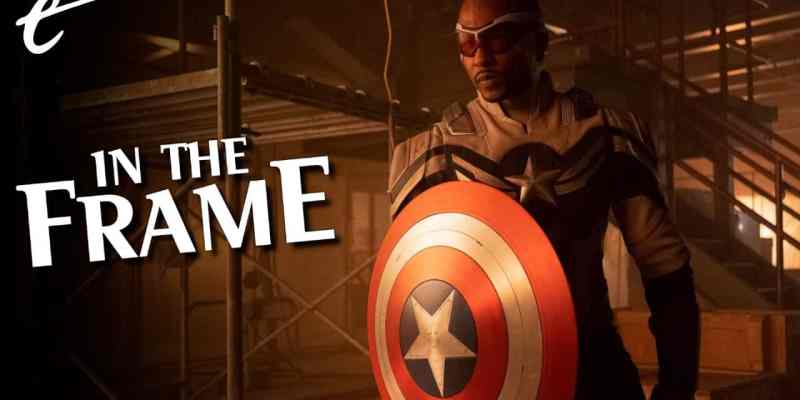Less than 12 hours after the release of the final episode of The Falcon and the Winter Soldier, Marvel Studios announced that Sam Wilson (Anthony Mackie) would be taking the iconic stars and stripes (and shield) to the silver screen in Captain America 4.
By all accounts, this was something of a surprise move. Anthony Mackie reportedly only discovered that he would be headlining Captain America 4 when somebody mentioned it to him at the grocery store. Still, there’s an obvious sense that Disney intends to build on The Falcon and the Winter Soldier. While no director is yet attached, the project was announced with The Falcon and the Winter Soldier showrunner Malcolm Spellman and writer Dalan Musson, marking it as a clear continuation of the steaming series.
This is interesting for a number of reasons, most obviously in what it suggests about the relationship between Disney’s streaming content and theatrical output. For years, the argument has been that Disney (like other studios) sees the future of production and distribution lying with an in-house subscription streaming service. Even before the pandemic, former Disney CEO Bob Iger signaled that an aggressive streaming strategy was both “necessary” and the company’s “number one priority.”
Obviously, the closure of cinemas during the pandemic only accelerated the streaming wars, forcing the release of tentpoles like Mulan and Wonder Woman 1984 on services like Disney+ and HBO Max. However, Iger’s successor Bob Chapek has conceded that “Covid accelerated the rate at which we made this transition, but this transition was going to happen anyway.” Chapek has echoed his predecessor’s insistence that streaming is “the company’s top priority.”
The period of transition is an interesting one, particularly for Disney. Thanks to hits like Avengers: Endgame, The Lion King, Frozen II, Captain Marvel, Star Wars: The Rise of Skywalker, Toy Story 4, and Aladdin, Disney enjoyed a record-breaking theatrical run in 2019. The studio had made more money than any studio in any previous year by July. By the close of the year, Disney had grossed $11 billion, surpassing its own previous record-breaking year (2016) by $5 billion. It was a frankly incredible run.

However, even before COVID-19 hit, there was a real question about what Disney could do next to maintain that box office hot streak. After all, many of those movies (like Endgame, Rise of Skywalker, and Toy Story 4) had been sold as end chapters to larger sagas. While the company would continue to remake its classic animated films in a photorealistic style, The Lion King and Aladdin arguably played out the last of best-loved hits.
In the wake of the big finale to the first decade of the Marvel Cinematic Universe, the company adopted an interesting approach. While relatively new franchises like Black Panther and Captain Marvel would continue on the big screen, most of the new theatrical properties seemed eccentric, more like Guardians of Galaxy than Captain America, movies like Chloé Zhao’s Eternals or Destin Daniel Cretton’s Shang-Chi and the Legend of the Ten Rings.
In contrast, many of the company’s more recognizable brands spun off in the direction of streaming services. Actors like Chris Evans and Robert Downey Jr. reached the end of their contracts with the company after splitting a decade between the larger Avengers projects and their solo Captain America and Iron Man trilogies, but those intellectual properties could not be left fallow. Instead, spin-offs for those brands were announced, but as streaming series rather than feature films.
Sam Wilson and Bucky Barnes (Sebastian Stan) would spin out of the Captain America franchise and into the Disney+ series The Falcon and the Winter Soldier. Characters like James Rhodes (Don Cheadle) and Riri Williams (Dominique Thorne) will carry the Iron Man brand to streaming shows like Armor Wars and Ironheart. Even Jennifer Walters (Tatiana Maslany) will bring The Incredible Hulk to digital with her She-Hulk miniseries.

Similarly, solo supporting characters from the Avengers franchise would spin-off into their own solo miniseries. Wanda Maximoff (Elizabeth Olsen) and Vision (Paul Bettany) headlined WandaVision. Loki (Tom Hiddleston) will round out the opening triptych of streaming shows with a self-titled series. Even Clint Barton (Jeremy Renner) will finally get some focus with a Hawkeye series allegedly drawing from Matt Fraction and David Aja’s beloved run.
Some first-generation characters retained a hold on the big screen. Jane Foster (Natalie Portman) will succeed the Odinson (Chris Hemsworth) and take the mantle of Thor in Thor: Love and Thunder, drawing from Jason Aaron’s recent comics run. Following the character’s death in Endgame, Natasha Romanoff (Scarlett Johansson) will receive a prequel Black Widow solo movie. However, those theatrical releases feel like concessions to Portman and Johansson as Oscar-winning-and-nominated stars.
When this strategy was announced before the pandemic, it seemed strange. After all, these were the company’s core brands: the original cast of The Avengers. More than that, if one bought into the old-fashioned hierarchy that places cinema above television, where it often seems like the best that television can aspire to be is “one big movie,” it felt like these familiar brands were receiving a demotion just as they became more diverse. Of course, the pandemic has changed that. Mostly.
Disney+ has accrued an impressive 94.9 million subscribers in just over a year, but that is still well below Netflix’s 203.66 million subscribers. For reference, IndieWire estimated that over 100 million people saw Endgame in its first weekend. (Endgame would enjoy a global multiplier of about 2.25x.) Marvel is also just one plank of Disney+, along with Star Wars, Pixar, National Geographic, and more. As such, the streaming series would not enjoy the reach of a theatrical release — at least for the moment.

In the streaming era, metrics are largely opaque. It is hard to tell how many people are watching a given show, as varying services offer competing metrics, and most numbers are self-reported. Still, Nielsen estimates that WandaVision was watched about 6.5 million times in America. Disney+ boasted that The Falcon and the Winter Soldier was its most-watched premiere ever, but data suggests Zack Snyder’s Justice League outpaced it. All evidence suggests that streaming figures are still well short of theatrical numbers.
For all the industry’s bluster, studios are still attached to the theatrical release model. While the pandemic has been brutal on cinemas, there is some evidence to suggest audiences are eager to return to the theater. Ironically, and perhaps unintentionally, Warner Bros.’ plan to release movies simultaneously on HBO Max and in theaters has given cinemas a lifeline. This raises an interesting question about the relationship between the streaming series and the feature films.
Which of these two product lines is more important to steering Marvel Studios as a brand? Which will serve as the “spine” of the shared universe? Which is the tail and which is the dog? For his part, Kevin Feige has stated that fans will “probably need a Disney+ subscription” to follow the upcoming theatrical releases. However, this may just be marketing copy, an attempt to weaponize audiences’ spoiler anxiety and differentiate these shows from the less integrated Netflix and ABC series.
Marvel’s two completed streaming series very consciously but very superficially tie into upcoming theatrical releases. The post-credits scene in WandaVision sets up Wanda’s supporting role in Doctor Strange and the Multiverse of Madness, which was announced over a year before WandaVision aired. While the announcement of Captain America 4 was more of a surprise, the existence of the film turns The Falcon and the Winter Soldier into an interesting detour in the journey of the characters.

The Falcon and the Winter Soldier is structured so that audiences could jump straight from Steve handing Sam the shield in Endgame through to Sam wielding it in Captain America 4. Sure, the show adds context and is worth enjoying on its own terms, but it doesn’t feel essential to that arc. The same is arguably true of the way in which WandaVision trolled fans by teasing the possible introduction of a game-changing concept like the multiverse or Mephisto or Fox’s X-Men.
Following Endgame was an impossible task. Any attempt to go bigger would likely fail, and any attempt to follow in a similar vein could seem tired. Instead, Marvel Studios pushed for quirkier theatrical releases like Eternals along with streaming detours like The Falcon and the Winter Soldier. It’s a canny approach. Hardcore fans can dive into the series to tide them over, while more casual fans can enjoy a respite before rejoining for Captain America 4 without missing much.
It appears that the old hierarchy of film “outranking” television is still in effect, with the shows feeling like trailers for upcoming films. Of course, these streaming shows are still in their infancy; Loki is still to air, closing Disney+’s opening salvo. There’s room to grow. Still, the announcement that The Falcon and the Winter Soldier would serve as a launching pad for Captain America 4 suggests that, while streaming might still be the company’s future, that future has yet to fully materialize.
